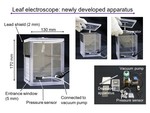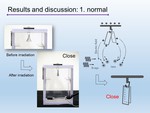Learning objectives
A textbook about radiation physics may begin with an explanation of “ionization”,
and the understanding of ionization is important for freshmen entered in a training radiology course (Fig.
1). Commonly known,
the phenomena of ionization occurs due to interactions between X-rays and atoms,
and in higher learning students obtain the knowledge that photoelectric and Compton scattering effects,
play an important role in understanding ionization [1-3]. But actually,
there are no proper educational experimental apparatuses to demonstrate ionization. The aim of our study is to fabricate...
Background
Figure 2 shows photographs of a newly developed leaf electroscope. The left photograph shows a side view of the apparatus. The outer size is 130 mm width,
130 mm length and 170 mm height. The main body of the apparatus is made of 10 mm thick polycarbonate. X-rays are introduced from the left side.
The entrance window has a100 mm width and 90 mm height,
and the thickness is 5 mm. To shield scattered X-rays from the movable diaphragm [5-7],
the left side of the...
Findings and procedure details
Figure 4 summarizes the results of experiments. For four different settings,
the experimental results concerning X-ray exposures of 10 mAs and 20 mAs are presented. The notation of “Open” and “Close” shows conditions of leaves after irradiation from X-rays; namely,
in the settings with “Close” results,
sufficient ions can be produced by irradiation from X-rays,
and the “Open” indicates that sufficient ions to close the leaves are not produced. For results at 10 mAs,
all of experiments show the same results,
“Open”,
therefore the X-ray...
Conclusion
In conclusion,
we developed a new leaf electroscope for educating beginners. The apparatus has two spaces; one is used for production of ions and electrons,
and charged leaves are placed in the other space. By observing the conditions of “Open” and “Close” for leaves,
one can easily understand the relationship between X-ray irradiations and productions of ions and electrons (ionization). The developed leaf electroscope almost works as well as we had wished,
but improvement of the entrance window is necessary to reduce interactions between incident...
Personal information
Hiroaki Hayashi
Assistant Professor,
Tokushima University Graduate School,
Japan.
[email protected]
References
[1] G.
F.
Knoll,
Radiation Detection and Measurement,
John Wiley and Sons,
Inc.,
2000.
[2] A.
B.
Wolbarst,
Physics of Radiology,
Medical Physics Publishing,
2005.
[3] F.
M.
Khan,
The Physics of Radiation Therapy,
Lippincott Williams & Wilkins,
2010.
[4] T.
Matsuura,
H.
Hayashi,
H.
Hanamitsu et al.,
Production of a Leaf Electroscope Having Separators and Proposal of an Experiment Using the Diagnostic X-ray Equipment,
Japanese Journal of Radiological Technology,
69(3),
239-243,
2013.
[5] I.
Maehata,
H.
Hayashi,
N.
Kimoto et al.,
Precise determination of...





